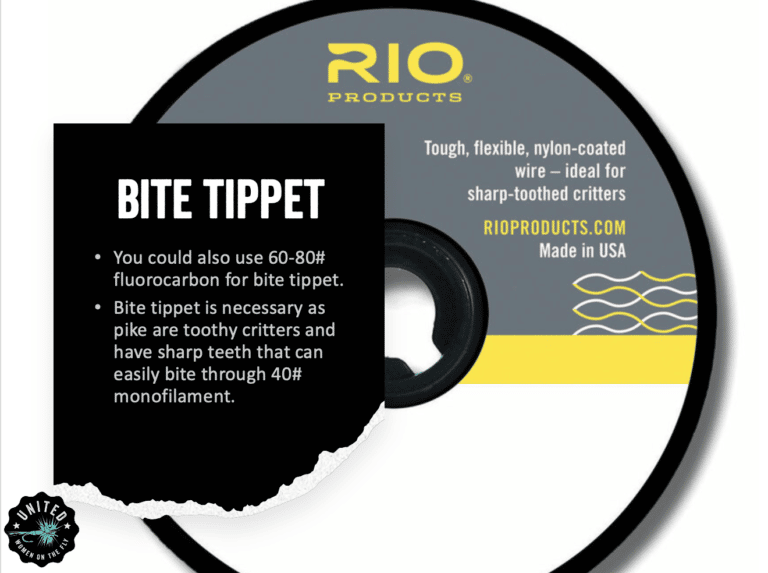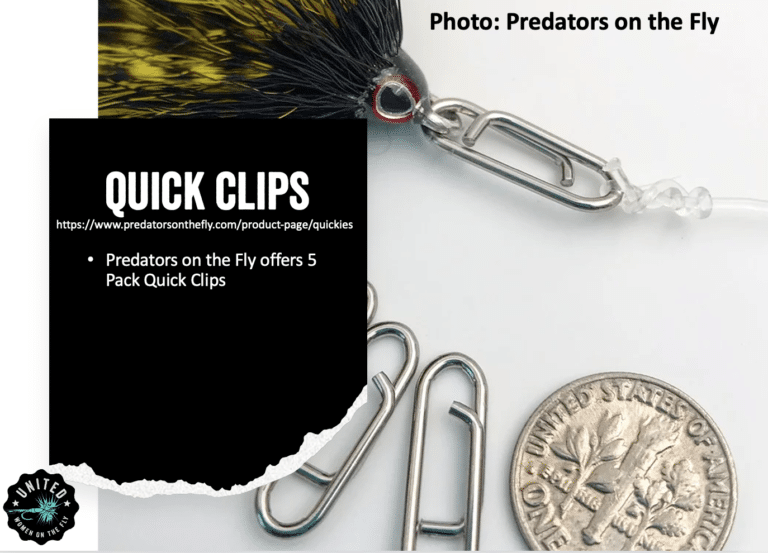Weeds and Structures
Pike can be found in rivers and lakes. Pike are ambush predators, so typically, I am looking for areas where pike can ambush bait fish. Pike typically do not cruise around searching for food. They will lurk motionless in the cover of weeds or other structures waiting for prey to come to them. Weed beds are an excellent place to target as pike will sit in the weeds waiting for an unsuspecting bait fish. Lilly pads and milfoil are good places to target in lakes. One place to target in a river is slower, swampy/slack-looking water next to faster-moving water – like a back eddy off the main current. Mouths of tributaries, drop-offs, points, and submerged trees are places where smaller fish (prey) will travel by, and pike will be nearby.
Equipment
- 7 – 10 wt Single Hand Rod
- Floating Line
- Intermediate Line
- Full Sink Line
- Wire Tippet or 60-90# Fluorocarbon
- Wire Cutters, Long Pliers, Jaw Spreaders and a Large Net
Rod Weight Depends on the FLy you are throwing
- 2-5 inch Fly = 7/8 Wt Rod
- 6-10 Inch Fly = 10 Wt Rod
Favorite Flies
- Larger Game Changers
- Flies with a Buford Head
- Articulated Heads
You don't have to throw big pike flies
You don’t have to throw big flies to catch pike. I have caught pike on size 2 woolly buggers. The most exciting way to catch pike – top water, of course! My favorite topwater fly is the Howitzer baitfish popper.
Fly Lines
I think that the most important piece of equipment is the fly line. I will use floating lines, intermediate lines, and full sink lines depending on the season and time of day I am fishing. The intermediate line is the line that I use the most, and I tend to use it in the late spring to summer months, as well as early morning or sunset fishing. I use a full sinking line for the fall and mid-day, as pike tend to go deeper during these times.
If using a floating line, you will want a line that has a short heavy head that can load the road quickly and helps turnover larger, heavier flies, like the Orvis Hydros Bank Shot line. A floating line paired with a poly leader is also a great way to fish if you cannot have multiple lines.
Leader Examples
I typically keep my leader relatively short, around 5-7 feet. 5 feet of level monofilament (30-40#) is a simple leader. Typically, I will run about 2.5 feet of 40# nylon or fluorocarbon to 2.5 feet of 25# nylon or fluorocarbon to 2 feet of bite tippet. I use 20-30# of knottable wire as my bite tippet (Rio, Surflon 7×7).
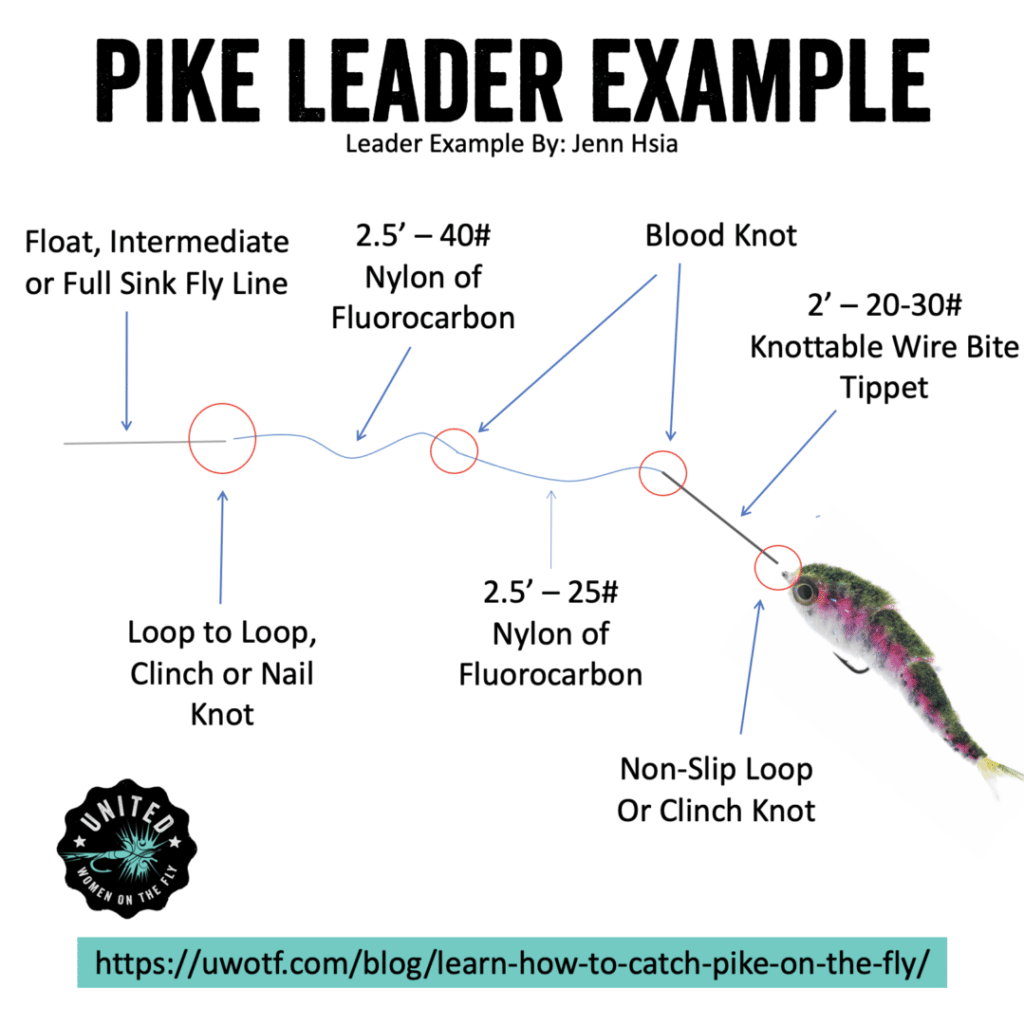
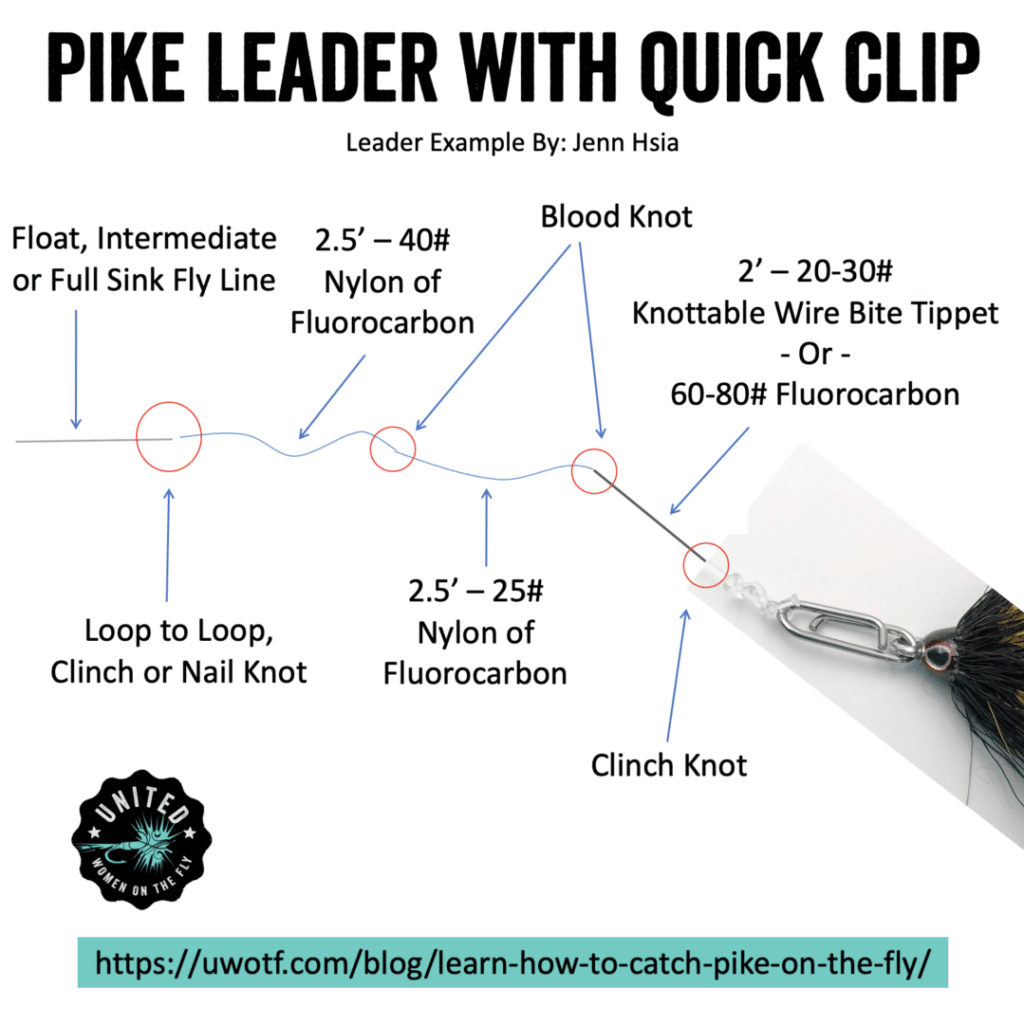
Wire Bite Tippet
You could also use 60-80# fluorocarbon for bite tippet. You can tie a clinch knot or non-slip mono loop knot with the wire. You can also tie the wire to a #4 stay-lock snap.
A floating line paired with a poly leader is also a great way to fish if you cannot have multiple lines.
Stay Locks or Quick Clips
The advantage of a stay-lock snap is that you can it saves you time and wire when changes flies as you can clip and unclip the fly quickly. Also, the stay-lock snap allows the fly to move freely in the water giving it more life and movement. Bite tippet is necessary as pike are toothy critters with sharp teeth that can easily bite through 40# monofilament.
Oval or Belgium Style Cast
An oval or Belgium-style cast is recommended if you use heavy or large flies and/or sinking lines. It is difficult to keep a traditional tight loop that we would use in trout fishing. Generally, your loops will be more open. Heavy flies will collapse your leader/line system if you employ a straight-line casting style. An oval cast keeps the line under constant tension, preventing the leader from collapsing. It helps keep the heavy flies from colliding with your rod tip while casting. While not essential, learning to haul will also help improve distance.
Strip Set
After the fly is in the water, as with all streamer fishing, try a variety of retrieves. Slow, fast, erratic, long pauses, anything can work. And, Strip set!!!
Unhook and Release a pike Safely
One thing to keep in mind about pike is that they are slimy, slippery fish and they have sharp teeth! The goal of unhooking a pike is to keep both yourself and the fish healthy. Never ever put your hand/fingers in a pike’s mouth! Their teeth can cause a lot of damage. Never “lip” a pike for the same reason. A net is helpful so that you can keep the fish in the water while preparing to unhook the pike.
One method to handle a pike is to perform a gill-plate grab. This grab controls the pike’s head and if done correctly, can help prevent a pike from sliding out of your grip and falling on the hard ground or boat floor. The gill-plate grab: Finger make a “U” (thumb not included). Slip fingers under the gill plate/cover which is on the undersurface of the head. The gill plate will always be white. Be sure not to put your fingers in the gills of the pike, which are red. In addition to damaging the gills, the gills have rakers which are like little teeth and can cut your fingers/knuckles. Place gentle outward pressure on the gill cover with your fingers. Place your thumb along the outside groove of the gill cover. Pinch your index and middle finger against the thumb in order to maintain control.
Never put your hand/fingers in a pike's mouth!
Jaw spreaders or long fliers
If you are uncomfortable using a gill-plate grab, jaw spreaders, and long pliers can be a good substitute. Gently grab the back of the pike’s head from above, preferably with the pike in the water. Turn the pike to the side and gently place the jaw spreaders. Take care to place the jaw spreaders on the bony portion of the jaw and not the thin membrane that makes up part of the lower jaw. Use long pliers to remove the hook. If you can’t remove the hook because it is too deep, cut it as close as possible and release the pike.
Photographing Pike
As with trout, try to limit the time out of water when taking a picture with the pike. Support the pike with both its head and body. Try not to hold a large pike completely vertically as that may crush and disrupt their internal organs. This is especially true of larger pike. Ideally, hold a pike in a more horizontal position. A gill plate grab can be used, or you can support the pike just behind its head. Fingers between the pectoral fins can help control the head. And support the lower half by the tail or gently hold the body by positioning your hands near the anal fins.
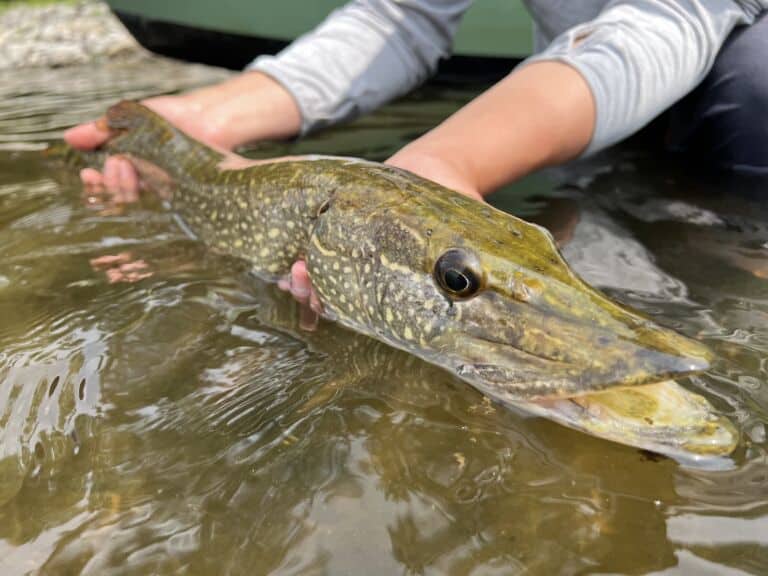
Releasing a Pike
When releasing a pike, you may need to revive the fish. It may take 30 seconds or may take 5 mins. Support the fish for as long as needed. Hold the tail to support the pike. No need to move the pike back and forth in the water. It is preferable to hold them still. Occasionally, turn them to their side. If they don’t right themselves, they are not yet recovered. When a pike is recovered, it will right itself when turned on its side and will start to move its tail. At that point, it is okay to let them go.
Watch the August UWOTF Virtual Meeting Presentation on Pike, Carp, and Musky Fishing Tips. Co-Hosts – Jenn Hsia, Lino Jubilado, and Nome Stark.
Connect with Jenn hSia
Jenn Hsia (she/her) @gojhsia is one of Fly Fish Instruct’s lead instructors since it’s creation in 2021. Jenn has quickly found the addition to the sport of fly fishing. Initially, Jenn started fly-fishing as a way to better appreciate the beautiful outdoors of Minnesota. Little did she know that she would become completely obsessed with it in such a short period of time.
The Driftless region of Minnesota/Wisconsin/Iowa is blessed with small spring creeks that hold brown, brook, and rainbow trout. It was there that Jenn learned how to cast, mend, and drift tiny little flies for some of the smartest trout.
Jenn’s passion is fishing for warm water species such as smallmouth bass and carp. She dabbles at times, trying to fish for musky, but much prefers pike. When Jenn isn’t fly fishing, you can probably find her looking for her next meal or restaurant to try out.


